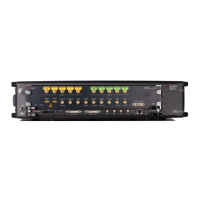A custom modulation file is an ASCII delimited file including all the information required
to define a single carrier modulated signal based in quadrature (IQ) modulation. The file
must be composed of a header including a series of lines with identifiers and
parameters, and a list of numerical correction factors. For lines including more than one
item (i.e. one identifier and one parameter), those must be separated using commas.
Identifiers and parameters are not case sensitive. These are the significant fields for the
header:
#N: This is a mandatory field and it must be the first in the file. The N parameter is
the bits per symbol parameter. 0<N<11.
Offset: It indicates if the Q component must be delayed by half a symbol time
respect to the I component. Accepted parameters are ‘yes’ or ‘no’. This parameter
is optional. It defaults to ‘no’ if not included in the file.
Rotation: It sets the rotation of the constellation for each consecutive symbol in
degrees. This parameter is optional. It defaults to 0.0 if not included in the file.
RotMode: Rotation mode. Parameter may be ‘cont’ (continuous) or ‘alt’ (alternate).
This parameter is optional. It defaults to ‘cont’ if not included in the file.
Vsb: It indicates that vestigial side band baseband filtering must be applied.
Accepted parameters are ‘yes’ or ‘no’. This parameter is optional. It defaults to ‘no’
if not included in the file.
The order of the above entries is not relevant except for the ‘#N’ field that must be
placed first in the file. The symbol location section starts with a line including the ‘IQ’
characters (not case-sensitive). Entries in this section are made by IQ pairs separated by
commas. The number of entries must be at least 2
N
although additional entries will be
ignored. Data to symbol mapping depends on the order of the symbols in the file so its
position expressed in binary format corresponds to the binary code assigned to that
symbol. Comments must start with the ‘//’ character sequence and may use a complete
line or be located at the end of any valid line (including the first line). Empty lines are
also valid.

